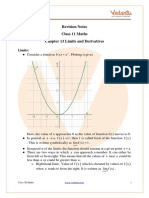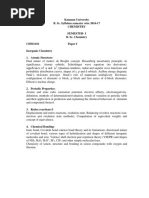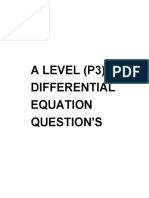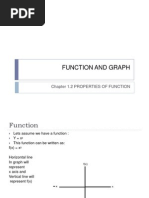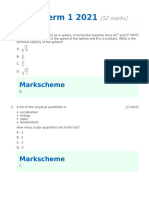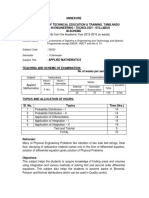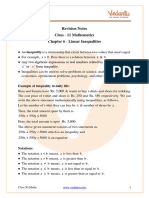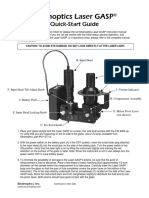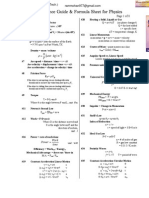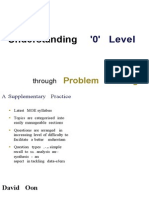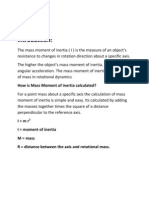Using Graphs
Uploaded by
wolfretonmathsUsing Graphs
Uploaded by
wolfretonmathsAQA Mechanics 1 Kinematics in one dimension
Section 1: Using graphs
Notes and Examples
These notes contain subsections on
Definitions
Displacement-time graphs
Velocity-time graphs and speed-time graphs
Distances and displacements from velocity-time and speed-time
graphs
Definitions
It is useful to understand from the start of your Mechanics work the difference
between a scalar quantity and a vector quantity. A vector quantity has
direction as well as size: for example a force is a vector quantity since it acts
in a particular direction. A scalar quantity does not have a direction associated
with it: for example mass is a scalar quantity.
The ideas of displacement, velocity and acceleration are very important in
Mechanics work. It is important to understand the distinction between distance
(a scalar quantity) and displacement (a vector quantity), and also between
speed (a scalar quantity) and velocity (a vector quantity).
Make sure you familiarise yourself with the definitions below.
Displacement is the shortest route between two points. A distance and
direction are needed. It is a vector quantity.
Position describes the location of something relative to a fixed point. This
fixed point is usually referred to as the origin. Like displacement, a distance
and direction are needed. It is a vector quantity.
The distance between two points involves no direction. It is just the physical
distance between the chosen points. It is a scalar quantity.
The distance travelled between two points does not have to be the same as
the distance between two points, described above. If you take a route which is
not direct, them the distance travelled will be greater than the direct distance
between the two points. Distance travelled is a scalar quantity.
To highlight the differences in the concepts of displacement, position, distance
and distance travelled, look at Example 1 below.
1 of 9
07/11/13 MEI
AQA M1 Kinematics in 1D 1 Notes and Examples
Example 1
O
5m
5m
An object starts from A and travels to the right to B, then back through A to O and
then back through A to stop at B.
Write down
(i)
The final displacement of the object
(ii)
The final position of the object
(iii) The distance between its starting and finishing points
(iv)
The total distance travelled by the object
Solution
(i)
The final displacement from its initial position at A is 5 m to the right.
(ii)
Its final position is 10 m right of O.
(iii) The distance between its starting and finishing points (A and B) is 5 m.
(iv)
The total distance travelled is 25 m: 5 m from A to B, 10 m from B to O and
another 10 m from O to B.
Speed is a scalar quantity; it just has a particular size, e.g. 5 ms -1. No
direction is given or implied. Speeds are always positive.
Velocity is a vector quantity. It must have a size and a direction, e.g. 6 ms -1
upwards.
Velocities can be either positive or negative.
Average speed = total distance travelled
total time taken
Average velocity = total displacement
total time taken
From these formulae it is possible to see why average velocity can be
negative if the resultant displacement is negative, whereas the total distance
travelled will always be positive.
Acceleration is a measure of how much velocity is changing. This means it
can affect both the speed and direction of motion. In this section you only
look at motion along a straight line, so only two directions are possible, either
forwards or backwards.
An acceleration of 2 ms-2 means that the velocity of a particle increases by
2 ms-1 every second (by 2 metres per second per second).
For example, if a car has an initial velocity of 6 ms-1 and an acceleration of
2 ms-2, then after 1 second its velocity will be 8 ms -1, after 2 seconds 10 ms-1
and after 3 seconds 12 ms1 etc.
2 of 9
07/11/13 MEI
AQA M1 Kinematics in 1D 1 Notes and Examples
If a particle has a negative acceleration but a positive velocity, then it will slow
down to a stop and then move in the opposite direction, with its speed steadily
increasing.
Take care with the word deceleration. It is probably better not to use it. Use
negative accelerations instead!
Remember that the units of acceleration are ms-2. This is usually read as
metres per second squared, or sometimes as metres per second per
second.
Displacement-time graphs
A displacement-time graph can be very useful in solving problems. Note the
following points:
The gradient of a displacement-time graph is given by
change in displacement
time
which is equal to the velocity.
A straight line on a displacement-time graph indicates that the
velocity is constant. If the gradient is positive then the velocity is
positive and if the gradient is negative then the velocity is negative.
A horizontal line on a displacement-time graph indicates that the
displacement is not changing: i.e. the object is stationary.
Parts of a displacement-time graph below the time axis indicate
that the displacement is negative: i.e. the object has moved to the
negative side of the origin.
The average velocity for a journey is given by
total displacement
time
The average speed for a journey is given by
total distance travelled
time
Notice that these may be different, if a journey involves moving in
both directions.
Example 2 illustrates the use of a displacement-time graph. Notice the
distinction between distance and displacement, and between speed and
velocity.
3 of 9
07/11/13 MEI
AQA M1 Kinematics in 1D 1 Notes and Examples
Example 2
Omar gets off a bus, walks to the shop to buy some milk, and then walks home. The
displacement-time graph below shows Omars journey.
displacement (m)
100
time (mins)
-100
-200
1
(i)
(ii)
(iii)
(iv)
(v)
(vi)
(vii)
(viii)
(ix)
(x)
What is Omars final displacement?
What is the total distance Omar has walked?
In which part of the journey was Omar walking fastest?
How far is the bus stop from Omars home?
How far is the shop from the bus stop?
What is Omars average speed for the whole journey?
What is Omars average velocity for the whole journey?
What is Omars average speed when he is actually walking?
Draw a speed-time graph for Omars journey.
Draw a velocity-time graph for Omars journey.
Note that this is negative
Solution
(i)
Omars final displacement is -250 m.
(ii)
The total distance walked is 150 + 400 = 550 m.
(iii)
Omar was walking fastest on the way home from the shop.
(iv)
The bus stop is 250 m from Omars house.
(v)
The shop is 150 m from the bus stop.
(vi)
Total distance travelled = 550 m.
Total time taken = 9.5 60 570 seconds.
550
0.965 ms-1 (3 s.f.)
Average speed
570
(vii)
Total displacement = -250
Total time taken = 9.5 60 570 seconds.
250
0.439 ms-1 (3 s.f.)
Average velocity
570
(viii)
Total distance travelled = 550 m.
4 of 9
because the direction of
the shop has been chosen
to be positive.
The last part of the
graph is steeper than
the first part.
07/11/13 MEI
AQA M1 Kinematics in 1D 1 Notes and Examples
Total time taken when walking = 7.5 60 450 seconds.
550
Average speed
1.222 ms-1 (3 s.f.)
450
150
1 ms-1.
2.5 60
400
Speed during journey from shop to home =
1.33 ms-1 (3 s.f.)
5 60
Speed during journey to shop
(ix)
speed (ms-1)
2
1
(x)
time (mins)
-1
Velocity during journey to shop = 1 ms .
Velocity during journey from shop to home = -1.33 ms-1 (3 s.f.)
velocity (ms-1)
2
1
0
time (mins)
-1
-2
Notice in Example 2 that if you want to know how fast Omar walks, then the
average speed and velocity calculations are not very helpful as they include
the time he spent at the shop. The calculation of average speed when he was
walking in part (vii) gives you the best idea of Omars walking speed.
Velocity-time graphs
Note the following points about velocity-time graphs.
The gradient of a velocity-time graph is given by
change in velocity
time
which is equal to the acceleration. You have to be careful in
interpreting the sign of the gradient: if it is positive, then either the
5 of 9
07/11/13 MEI
AQA M1 Kinematics in 1D 1 Notes and Examples
velocity is positive and it is getting more positive, i.e. speeding up,
or it is negative and is getting less negative, i.e. slowing down. If
the gradient is negative, then either the velocity is positive and is
getting less positive, i.e. slowing down, or the velocity is negative
and is getting more negative, i.e. speeding up.
A straight line on a velocity-time graph indicates that the
acceleration is constant. If the gradient is positive then the
acceleration is positive and if the gradient is negative then the
acceleration is negative.
A horizontal line on a velocity-time graph indicates that the velocity
or speed is not changing: i.e. the object is moving at a constant
speed.
Parts of a velocity-time graph below the time axis indicate that the
velocity is negative: i.e. the object is moving in the negative
direction (although the displacement may still be positive).
The diagram below shows a velocity-time graph.
velocity
12
3
16
10
18
time
The straight line from t = 0 to t = 3 indicates that the particle is accelerating
with constant acceleration. The horizontal line from t = 3 to t = 7 indicates that
it is moving with constant speed. The line from t = 7 to t = 10 indicates that it is
moving with constant negative acceleration, i.e. it is slowing down, and at t =
10 it is instantaneously stationary.
From t = 10 to t = 12, the particle has negative velocity and negative
acceleration. Although negative acceleration is associated with the idea of
slowing down, because the velocity is negative it is in fact becoming more
negative, so the velocity is decreasing but its magnitude (the speed) is
increasing.
From t = 12 to t = 16, the velocity is constant. It is negative, meaning that the
particle is still moving in a negative direction.
6 of 9
07/11/13 MEI
AQA M1 Kinematics in 1D 1 Notes and Examples
From t = 16 to t = 18, the particle has negative velocity and positive
acceleration. The velocity is becoming less negative, so the velocity is
increasing but its magnitude (the speed) is decreasing.
Example 3
When a local train leaves a station, it takes accelerates at a uniform rate of 3 ms -2 to
its maximum speed of 60 ms-1. It then maintains this speed for 2 minutes before
slowing down uniformly to a halt at the next station. The whole journey takes 3
minutes.
(i)
(ii)
(iii)
(iv)
Sketch a displacement-time graph for the journey.
Find the time the train takes to reach its maximum speed.
Draw the velocity-time graph for the journey.
What is the acceleration of the train in the last part of the journey?
Solution
(i)
distance
Here the train is
slowing down
Here the train is
travelling at
constant speed
Here the train is
accelerating
(ii)
Acceleration
change in velocity
time
time
60 0
t
60
t
20
3
The train takes 20 seconds to reach its maximum speed.
3
(iii)
velocity (ms-1)
60
2
7 of 9
time (mins)
07/11/13 MEI
AQA M1 Kinematics in 1D 1 Notes and Examples
(iv)
The last part of the journey takes 40 seconds, and the velocity changes from
60 ms-1 to 0.
change in velocity
Acceleration
time
0 60
40
1.5
The acceleration is -1.5 ms-2.
Distances and displacements from velocity-time and speedtime graphs
The area under a velocitytime graph is usually equal to the distance a
particle travels in the given time period, as long as the line does not cross the
time axis (which is the same as saying the velocity is always positive).
However, if the graph crosses the time axis (which is the same as saying the
velocity becomes negative), the situation changes so that the distance
travelled is equal to the sum of the areas between the graph and the time
axis, disregarding the negative sign, whereas the displacement is equal to the
sum of the areas, incorporating the negative sign.
If the velocity-time graph is made up of a series of curves, then the area can
be approximated by counting squares or by approximating the curve by
straight lines to produce trapezia (as for the trapezium rule).
Example 4
The diagram shows the velocity-time graph for the journey of a particle moving in a
straight line.
velocity (ms-1)
4
2
20
5
10
15
time (s)
-2
-4
(i)
(ii)
(iii)
(iv)
What is the acceleration of the particle during the first part of the journey?
How far does the particle travel in the first 12 seconds of its motion?
Estimate the distance travelled in the final 5 seconds of the motion.
What is the total distance travelled by the particle?
8 of 9
07/11/13 MEI
AQA M1 Kinematics in 1D 1 Notes and Examples
(v)
(vi)
(vii)
What is the final displacement of the particle?
Find the average speed of the particle.
Find the average velocity of the particle.
Solution
(i)
During the first part of the journey the velocity of the particle increases from 0
to 4 ms-1 in 5 seconds.
change in velocity
Acceleration
time
40
5
0.8
Acceleration = 0.8 ms-2.
(ii)
Distance travelled = area under graph between t = 0 and t = 12.
Area under graph between t = 0 and t = 5 is 12 5 4 10
Area under graph between t = 5 and t = 8 is 3 4 12
Area under graph between t = 8 and t = 12 is 12 4 4 8
Total area = 10 + 12 + 8 = 30
Distance travelled = 30 m.
(iii)
Splitting up the shape as shown in the diagram:
Area of trapezium A 12 3 2 3 7.5
Area of triangle B 12 2 2 2
Total area = 9.5
Distance travelled 9.5 m.
20
15
B
A
(iv)
Distance travelled between t = 12 and t = 15 is 12 3 3 4.5
Total distance travelled = 30 + 4.5 + 9.5 = 44 m.
(v)
Final displacement = 30 (4.5 + 9.5) = 16 m.
(vi)
Average speed
(vi)
Average velocity
total distance
time
44
2.2 ms -1
20
total displacement
time
16
0.8 ms -1
20
9 of 9
07/11/13 MEI
You might also like
- Using Parametric Equations - Solutions PDFNo ratings yetUsing Parametric Equations - Solutions PDF4 pages
- Differentiation Under The Integral SignNo ratings yetDifferentiation Under The Integral Sign14 pages
- MATH 6210 Outlier Syllabus - Fall 2020 - Regular Term (14-wk) - 11-4No ratings yetMATH 6210 Outlier Syllabus - Fall 2020 - Regular Term (14-wk) - 11-47 pages
- Mechanical Mathematics Syllabus: Forms 5 - 6No ratings yetMechanical Mathematics Syllabus: Forms 5 - 626 pages
- Class 11 Revision Notes Limits and DerivativesNo ratings yetClass 11 Revision Notes Limits and Derivatives10 pages
- B.SC - Semester Chemistry - Syllabus ToNo ratings yetB.SC - Semester Chemistry - Syllabus To23 pages
- n3 Physics Revision Notes - Waves and Radiation Farr HsNo ratings yetn3 Physics Revision Notes - Waves and Radiation Farr Hs10 pages
- 2.4 Differentiation of Trigonometric FunctionsNo ratings yet2.4 Differentiation of Trigonometric Functions16 pages
- Beyond On Symmetrical Algebraic ExpressionsNo ratings yetBeyond On Symmetrical Algebraic Expressions9 pages
- 3.4 The Fundamental Theorem of Algebra, Sum and Product of The Zeros of PolynomialsNo ratings yet3.4 The Fundamental Theorem of Algebra, Sum and Product of The Zeros of Polynomials4 pages
- More Examples From 10.4: Math 1432 Notes - Week 10No ratings yetMore Examples From 10.4: Math 1432 Notes - Week 1017 pages
- V Best Chapter 1.1 Quadratics - ONLINE PDFNo ratings yetV Best Chapter 1.1 Quadratics - ONLINE PDF16 pages
- Function and Graph: Chapter 1.2 Properties of Function100% (1)Function and Graph: Chapter 1.2 Properties of Function22 pages
- Kinematics Subjective Problems-SP-NPJC I-Jun 13No ratings yetKinematics Subjective Problems-SP-NPJC I-Jun 1311 pages
- Height of A Zero Gravity Parabolic Flight ProjectNo ratings yetHeight of A Zero Gravity Parabolic Flight Project4 pages
- The Fractional Fourier Transform and Time-Frequency RepresentationsNo ratings yetThe Fractional Fourier Transform and Time-Frequency Representations8 pages
- The Second Differential: Ib SL/HL Adrian SparrowNo ratings yetThe Second Differential: Ib SL/HL Adrian Sparrow7 pages
- Notes Topic 3.15 Key Rates of Change in Polar FunctionsNo ratings yetNotes Topic 3.15 Key Rates of Change in Polar Functions5 pages
- Linear Inequalities Class 11 Notes CBSE Maths Chapter 6 (PDF)No ratings yetLinear Inequalities Class 11 Notes CBSE Maths Chapter 6 (PDF)7 pages
- C.1 Simple Harmonic Motion Revision TeacherNo ratings yetC.1 Simple Harmonic Motion Revision Teacher42 pages
- Comprehensive Guide to LaTeX: Advanced Techniques and Best PracticesFrom EverandComprehensive Guide to LaTeX: Advanced Techniques and Best PracticesNo ratings yet
- Using Partial Fractions in Integration Exercise PDFNo ratings yetUsing Partial Fractions in Integration Exercise PDF1 page
- Vectors in Two & Three Dimensions Exercise PDFNo ratings yetVectors in Two & Three Dimensions Exercise PDF2 pages
- Color Science: Concepts and Methods, Quantitative Data and Formulae0% (3)Color Science: Concepts and Methods, Quantitative Data and Formulae8 pages
- Pre-Term-II - Class XII Studying - Test-1 - Code-B - Physics - SolutionNo ratings yetPre-Term-II - Class XII Studying - Test-1 - Code-B - Physics - Solution6 pages
- OP 31 Lighting Requirements For Television Issue 3 January 2015No ratings yetOP 31 Lighting Requirements For Television Issue 3 January 201517 pages
- Formulas For Ultrasonic Nondestructive TestingNo ratings yetFormulas For Ultrasonic Nondestructive Testing3 pages
- Fourier Transform Infra Red (FTIR) : Group 3 Dwi Yuliantiningsih Wifqul Laili Riski Ayu Candra Rina Rukaenah100% (1)Fourier Transform Infra Red (FTIR) : Group 3 Dwi Yuliantiningsih Wifqul Laili Riski Ayu Candra Rina Rukaenah19 pages
- Chip Scale Atomic Magnetometer Based On SERF100% (2)Chip Scale Atomic Magnetometer Based On SERF4 pages
- Microscopy: Dr. Ashish Jawarkar M.D. Consultant Pathologist Parul Sevashram HospitalNo ratings yetMicroscopy: Dr. Ashish Jawarkar M.D. Consultant Pathologist Parul Sevashram Hospital21 pages
- Phase Contrast Microscopy: Figure 1 - Schematic of A Phase Contrast Microscope. FromNo ratings yetPhase Contrast Microscopy: Figure 1 - Schematic of A Phase Contrast Microscope. From4 pages
- Sumulong College of Arts and Sciences: Preliminary Examination 2 Semester, SY 2019-2020No ratings yetSumulong College of Arts and Sciences: Preliminary Examination 2 Semester, SY 2019-202010 pages
- 8.2 Determination of The Wavelength of Light by Grating DiffractionNo ratings yet8.2 Determination of The Wavelength of Light by Grating Diffraction12 pages
- MATH 6210 Outlier Syllabus - Fall 2020 - Regular Term (14-wk) - 11-4MATH 6210 Outlier Syllabus - Fall 2020 - Regular Term (14-wk) - 11-4
- A Complete Course in Physics (Graphs) - First EditionFrom EverandA Complete Course in Physics (Graphs) - First Edition
- n3 Physics Revision Notes - Waves and Radiation Farr Hsn3 Physics Revision Notes - Waves and Radiation Farr Hs
- 3.4 The Fundamental Theorem of Algebra, Sum and Product of The Zeros of Polynomials3.4 The Fundamental Theorem of Algebra, Sum and Product of The Zeros of Polynomials
- More Examples From 10.4: Math 1432 Notes - Week 10More Examples From 10.4: Math 1432 Notes - Week 10
- Function and Graph: Chapter 1.2 Properties of FunctionFunction and Graph: Chapter 1.2 Properties of Function
- The Fractional Fourier Transform and Time-Frequency RepresentationsThe Fractional Fourier Transform and Time-Frequency Representations
- Notes Topic 3.15 Key Rates of Change in Polar FunctionsNotes Topic 3.15 Key Rates of Change in Polar Functions
- Linear Inequalities Class 11 Notes CBSE Maths Chapter 6 (PDF)Linear Inequalities Class 11 Notes CBSE Maths Chapter 6 (PDF)
- Comprehensive Guide to LaTeX: Advanced Techniques and Best PracticesFrom EverandComprehensive Guide to LaTeX: Advanced Techniques and Best Practices
- Using Partial Fractions in Integration Exercise PDFUsing Partial Fractions in Integration Exercise PDF
- Color Science: Concepts and Methods, Quantitative Data and FormulaeColor Science: Concepts and Methods, Quantitative Data and Formulae
- Pre-Term-II - Class XII Studying - Test-1 - Code-B - Physics - SolutionPre-Term-II - Class XII Studying - Test-1 - Code-B - Physics - Solution
- OP 31 Lighting Requirements For Television Issue 3 January 2015OP 31 Lighting Requirements For Television Issue 3 January 2015
- Fourier Transform Infra Red (FTIR) : Group 3 Dwi Yuliantiningsih Wifqul Laili Riski Ayu Candra Rina RukaenahFourier Transform Infra Red (FTIR) : Group 3 Dwi Yuliantiningsih Wifqul Laili Riski Ayu Candra Rina Rukaenah
- Microscopy: Dr. Ashish Jawarkar M.D. Consultant Pathologist Parul Sevashram HospitalMicroscopy: Dr. Ashish Jawarkar M.D. Consultant Pathologist Parul Sevashram Hospital
- Phase Contrast Microscopy: Figure 1 - Schematic of A Phase Contrast Microscope. FromPhase Contrast Microscopy: Figure 1 - Schematic of A Phase Contrast Microscope. From
- Sumulong College of Arts and Sciences: Preliminary Examination 2 Semester, SY 2019-2020Sumulong College of Arts and Sciences: Preliminary Examination 2 Semester, SY 2019-2020
- 8.2 Determination of The Wavelength of Light by Grating Diffraction8.2 Determination of The Wavelength of Light by Grating Diffraction






















